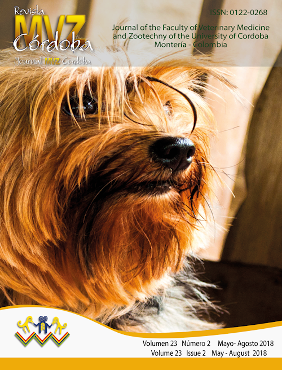Bacterial Contaminants and Antimicrobial Susceptibility Profile of Boar Semen in Southern Brazil Studs
Contaminantes bacterianos y perfil de susceptibilidad del semen porcino en centros de recogida em Brasil
Show authors biography
Objective: To assess the microbiological profile in seven Boar Studs (BS) in Southern Brazil, as well as evaluate antimicrobial susceptibility response to most commonly found microorganisms in BS. Material and methods: Bacteriologic analysis was carried out in samples from the water purification system, semen extender, raw and stored semen, lab benches, and other working surfaces. Results: Growth of a mixed bacterial population was observed in water samples from all but one BS. Approximately 85% of the BS had significant contamination on their working surfaces with at least one bacterial contaminant. A total of 86% of raw semen samples were contaminated with one or more different bacteria, while 100% of the boar studs provided contaminated samples. Bacterial susceptibility to antimicrobial agents varied from over 80% for gentamycin, neomycin and ceftiofur to 40% or less for penicillin and lincomycin. Conclusions: The identification of the critical points provides necessary support to devise better strategies to minimize contamination in BS. Also, assessing the level of antimicrobial drug resistance offers accurate information to formulate more efficient antibacterial protocols that closely observe the rational use of antibiotics.
Article visits 2015 | PDF visits
Downloads
- Bortolozzo FP, Menegat MB, Mellagi APG, Bernardi ML, Wentz I. New artificial insemination technologies for swine. Reprod Dom Anim. 2015; 50(Suppl. 2):80-84.
- Riesenbeck A. Review on international trade with boar semen. Rep Domestic Anim. 2011; 46(Suppl. 2):1-3.
- Morrell JM. Antimicrobials in boar semen extenders – A risk / Benefits analysis. J Antimicrob. 2016; 2(1):107-108.
- Althouse GC. Sanitary Procedures for the Production of Extended Semen. Reprod Dom Anim. 2008; 43:374-378. https://doi.org/10.1111/j.1439-0531.2008.01187.x
- Althouse GC, Pierdon MS, Lu KG. Thermotemporal dynamics of contaminant bacteria and antimicrobials in extended porcine semen. Theriogenol. 2008; 70:1317-1323. https://doi.org/10.1016/j.theriogenology.2008.07.010
- Bussalleu E, Yeste M, Sepúlveda L, Torner E, Pinart E, et al. Effects of different concentrations of enterotoxigenic and verotoxigenic E. coli on boar sperm quality. Anim Reprod Sci. 2011; 127: 176-182. https://doi.org/10.1016/j.anireprosci.2011.07.018
- Schultze M, Ammon C, Rudiger K, Jung M, Grobbel M. Analysis of hygienic critical points in boar semen production. Theriogenology. 2015; 83:430-437. https://doi.org/10.1016/j.theriogenology.2014.10.004
- Schulze M, Grobbel M, Muller KM, Junkes C, Dathe M, Rudiger KR, Jung M. Challenges and limits using antimicrobial peptides in boar semen preservation. Reprod Dom Anim. 2015; 50(Suppl 2):5-10.
- Grossfeld R, Peralta W, Weitze K, Waberski D. Antibiotic-free hypothermic storage of boar semen in Androstar +5 extender results in similar fertility results compared to semen stored at 17°C in extender with antibiotic content. Anim Reprod Sci. 2016; 169:125. https://doi.org/10.1016/j.anireprosci.2016.03.071
- Schulze M, Ammon C, Rüdiger K, Kung M, Grobblel M. Analysis of hygienic critical control points in boar semen production. Theriogenol. 2015; 83(3):430-437. https://doi.org/10.1016/j.theriogenology.2014.10.004
- Gaczarzewicz D, Udala J, Piasecka M, Blaszczyk B, Stankiewicz T. Bacterial contamination of boar semen and its relationship to sperm quality preserved in commercial extender containing gentamicin sulfate. Polish J Vet Sci. 2016; 19(3):451–459. https://doi.org/10.1515/pjvs-2016-0057
- Markey B, Leonard F, Archambault M, Cullinane A, Maguire D. Clinical Veterinary Microbiology, 2013; 2 ed. MOSBY Elsevier, p. 27-49; 920 pp.
- CLSI. Developtment of In Vitro Susceptibility Testing Criteria and Quality Control Parameters. 5th Ed. CLSI guideline 23. Wayne, PA: Clinical and Laboratory Standards Institute; 2018.
- Althouse GC. Sanitary procedures for the production of extended semen. Reprod Dom Anim. 2008; 43:374-378. https://doi.org/10.1111/j.1439-0531.2008.01187.x
- Rodriguez AL, Soom AV, Arsenakis I, Maes D. Boar management and semen handling factors affect the quality of boar extended semen. Porcine Health Management. 2017; 3:15. https://doi.org/10.1186/s40813-017-0062-5
- Payne BJ, Clark S, Maddox C, Ness A. Achromobacter xylosoxidans in extended semen causes reproductive failure in artificially inseminated sows and gilts. J Swine Health Prod. 2008; 16(6):316-322.
- Gary E Ritchie. Water for Pharmaceutical Purposes USP 24/NF. 2000; 30(5):1744. URL available in: http://www.pharmacopeia.cn/v29240/usp29nf24s0_c1231.html
- Bresciani C, Cabassi CS, Morini G, Taddei S, Bigliardi E, Di Lanni F, Sabboni A, Parmigiani E. Boar semen bacterial contamination in Italy and antibiotic efficacy in a modified extender. Ital J Anim Sci. 2014; 13:3082. https://doi.org/10.4081/ijas.2014.3082
- Tremblay YDN, Hathroubi S, Jacques M. Les biofilms bactériens: leur importance en santé animale et en santé publique. Canadian J Vet Res. 2014; 78(2): 110-116.
- Fuster-Valls N, Hernández-Herrero M, Marín-de-Mateo M, Rodríguez-Jerez JJ. Effect of different environmental conditions on the bacteria survival on stainless steel surfaces. Food Cont. 2008; 19:308-314. https://doi.org/10.1016/j.foodcont.2007.04.013
- Rode TM, Langsrud S, Holck A, Moretro T. Different patterns of biofilm formation in Staphylococcus aureus under food-related stress conditions. Int J Food Microbiol. 2007; 116:372-383. https://doi.org/10.1016/j.ijfoodmicro.2007.02.017
- De Souza EL, Meira QG, Barbosa IM, Athayde AJAA, Conceição ML, Siqueira-Junior JP. Biofilm formation by Staphylococcus aureus from food contact surfaces in a meat-based broth and sensitivity to sanitizers. Braz J Microbiol. 2014; 45(1):67-75. https://doi.org/10.1590/S1517-83822014000100010
- Úbeda JL, Ausejo R, Dahmani Y, Falceto MV, Usan A, Malo C, Perez-Martinez FC. Adverse effects of members of the Enterobacteriaceae family on boar sperm quality. Theriogenol. 2013; 80:565-570. https://doi.org/10.1016/j.theriogenology.2013.05.022
- Mazurova J, Kukla R, Rozkot M, Lustykova A, Slehova E, Sleha R, Lipensky J, Opletal L. Use of natural substances for boar semen decontamination. Vet Med. 2015; 60:235–247. https://doi.org/10.17221/8175-VETMED
- Korpimäki T, Kurittu J, Karp M. Surprisingly fast disappearance of β-lactam selection pressure in cultivation as detected with novel biosensing approaches. J Microbiol Met. 2003; 53(1):37–42. https://doi.org/10.1016/S0167-7012(02)00213-0
- Goldberg AMG, Argenti LE, Faccin JE, Linck L, Santi M, Bernardi ML, Cardoso, MRI; Wentz, I; Bortolozzo, FP. Risk factors for bacterial contamination during boar semen collection. Res Vet Sci. 2013; 95:362–367. https://doi.org/10.1016/j.rvsc.2013.06.022
- Clinical and Laboratory Standards Institute (CLSI), Performance Standard for Antimicrobial Susceptibility Testing; TwentyFourty Informational Supplement. CLSI document M100-S24. Wayne, PA, USA; 2014.
























